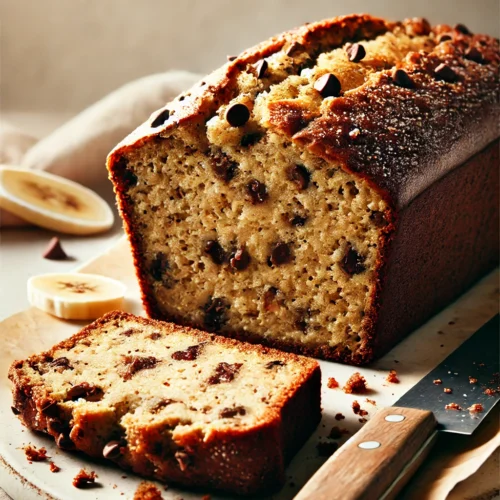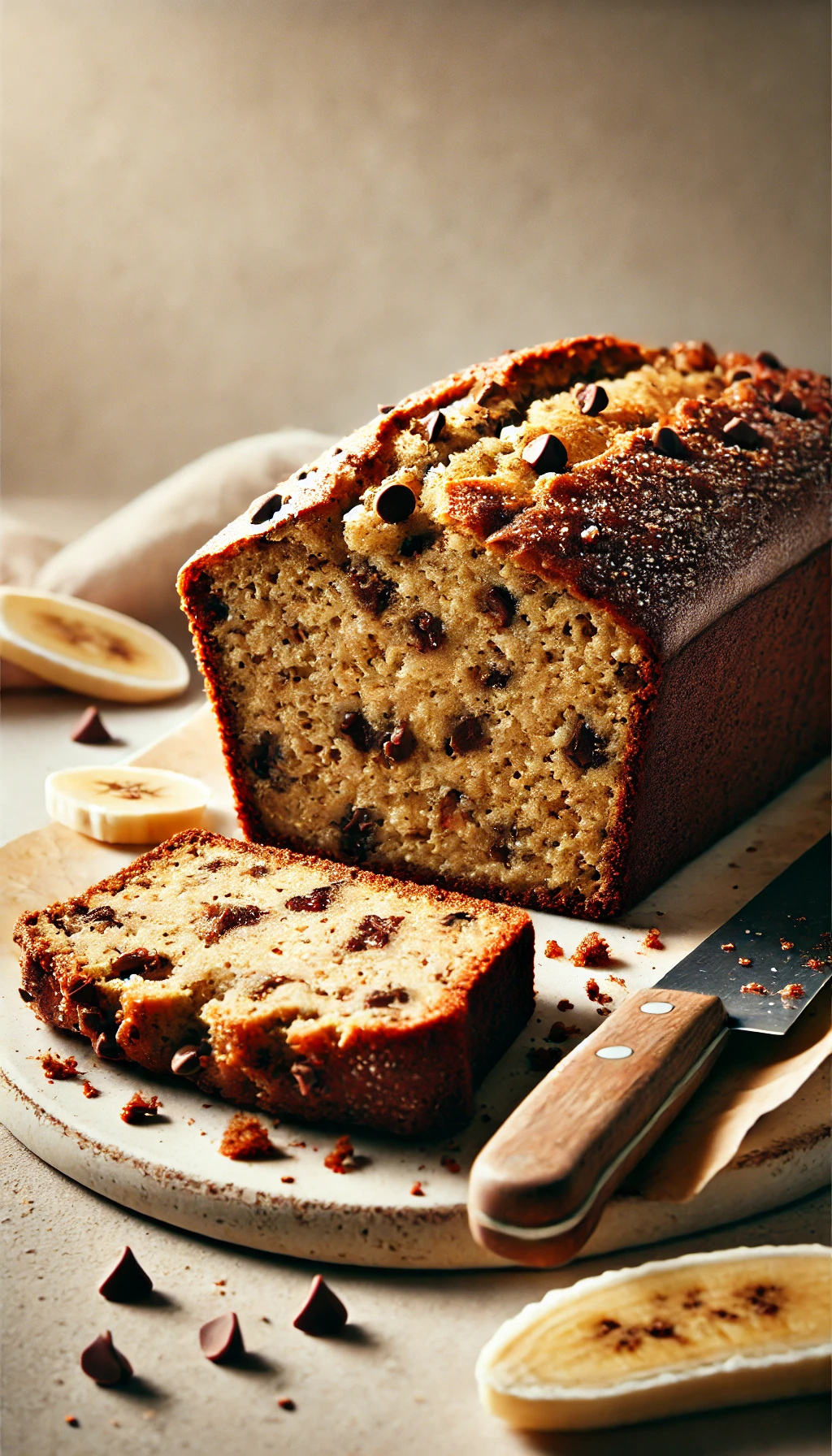Introduction: Why Banana Bread is a Timeless Favorite ?
Banana Bread is more than just a recipe. It’s a journey through time, a symbol of culinary ingenuity, and a testament to the adaptability of cooks in response to economic, social, and cultural changes. This article delves into its origins, evolution, variations, and global culinary impact.
Origins of Banana Bread: A Story of Adaptation and Creativity
1. The Role of Bananas in Global Cuisine
Bananas, originally from Southeast Asia, were introduced to Europe and the Americas through colonial trade. Their widespread availability in Western markets in the 19th century marked the beginning of their use in desserts and snacks.

2. The Rise of Banana Bread in the 1930s
The Great Depression of the 1930s in the United States gave birth to Banana Bread as a way to prevent food waste. Overripe bananas were no longer discarded but transformed into this delicious baked good.

3. Innovations in Key Ingredients
- Baking powder and baking soda: These leavening agents, introduced in the late 19th century, revolutionized home baking, enabling soft, fluffy textures without yeast.
- Cookbooks as cultural tools: Recipes like Banana Bread gained popularity through cookbooks like “Pillsbury Balanced Recipes” (1933), making it a household staple.

Banana Bread Through the Decades
1. A Wartime Favorite in the 1940s
During World War II, rationing limited access to sugar and butter, making bananas a valuable natural sweetener. Banana Bread became a wartime favorite.
2. The Health Food Movement of the 1970s
The 1970s brought a renewed interest in Banana Bread as part of the natural food movement. Whole wheat flour, honey, and nuts were incorporated, transforming it into a health-conscious treat.
3. The Modern Banana Bread Boom
Banana Bread experienced a resurgence during the COVID-19 pandemic, with millions of people baking it at home as a comforting and nostalgic activity.

Key Components of Banana Bread
1. Essential Ingredients
- Overripe bananas: The key to its natural sweetness and moist texture.
- Flour: All-purpose, whole wheat, or even gluten-free options.
- Eggs and butter: For structure and richness.
- Sugar: White, brown, or substitutes like maple syrup.

2. Modern Additions
- Nuts and seeds: Pecans, walnuts, or chia seeds for crunch.
- Chocolate: Dark or white chocolate chips for an indulgent twist.
- Spices: Cinnamon or nutmeg for warmth.

Banana Bread: Why It’s Irresistible
1. Versatility and Adaptability
Banana Bread can be:
- A quick breakfast with coffee or tea.
- A snack for children and adults.
- A dessert, paired with ice cream or whipped cream.
2. Simplicity in Execution
Even beginners can make Banana Bread successfully. No special equipment is needed, and most ingredients are pantry staples.
3. A Cultural Icon
Banana Bread embodies universal values: anti-waste, comfort, and creativity. It represents an intergenerational tradition where recipes are passed down and reinvented.
Famous Variations of Banana Bread
1. Vegan Banana Bread
Vegan Banana Bread is a fantastic alternative for those following a plant-based lifestyle, avoiding animal products, or simply looking for a healthier, more sustainable twist on the classic recipe. This variation is not only delicious but also showcases the versatility of plant-based ingredients in recreating the moist, rich texture and flavor of traditional Banana Bread.
1. Key Ingredient Substitutions
In Vegan Banana Bread, animal-derived ingredients like butter, eggs, and dairy are replaced with plant-based alternatives that mimic their texture and functionality:
- Butter Replacement:
- Coconut Oil: Adds richness and a subtle tropical flavor.
- Plant-Based Margarine: Works well for a more neutral taste.
- Nut Butters: Such as almond or cashew butter, which add a creamy texture and a nutty flavor.
- Egg Replacement:
- Flax Seeds: Combine 1 tablespoon of ground flaxseeds with 2.5 tablespoons of water to create a “flax egg.” This binds the ingredients and adds nutrients like omega-3 fatty acids.
- Chia Seeds: Similar to flaxseeds, a chia egg (1 tablespoon chia seeds + 2.5 tablespoons water) offers a slightly denser texture.
- Mashed Bananas: An obvious choice, bananas not only replace eggs but also enhance the flavor.
- Milk Replacement:
- Plant-Based Milk: Almond, soy, oat, or coconut milk are perfect substitutes, adding moisture and a subtle flavor.
- Butter Replacement:
2. Health Benefits
Vegan Banana Bread is often seen as a healthier option due to its reliance on whole, plant-based ingredients:
- No Cholesterol: The absence of butter and eggs makes this recipe heart-healthy.
- Rich in Fiber: Bananas and flaxseeds contribute to improved digestion.
- Lower Saturated Fat: When using oils like olive or avocado oil, the bread becomes a healthier indulgence.
3. Preparation Tips
- Don’t Overmix: Vegan batters can sometimes turn gummy if overmixed. Stir just until the ingredients are combined.
- Use Overripe Bananas: They’re naturally sweeter and provide more moisture.
- Experiment with Flavors: Add cinnamon, vanilla extract, or even a touch of nutmeg to complement the banana flavor.
4. Flavorful Add-Ins
Vegan Banana Bread offers endless opportunities for customization:
- Chocolate Chips: Use dairy-free or dark chocolate chips for a touch of indulgence.
- Nuts: Walnuts, pecans, or almonds add crunch and depth.
- Dried Fruits: Raisins, dried cranberries, or chopped dates introduce natural sweetness.
- Seeds: Sprinkle pumpkin or sunflower seeds on top for a decorative and nutritious finish.
5. Sustainable and Ethical Appeal
Choosing vegan Banana Bread aligns with environmentally friendly and ethical eating habits:
- Reduced Carbon Footprint: Plant-based ingredients have a lower environmental impact.
- No Animal Harm: Perfect for those following an ethical vegan lifestyle.
6. Variations to Explore
- Gluten-Free Vegan Banana Bread: Use almond or oat flour to make it gluten-free while keeping it plant-based.
- Chocolate Vegan Banana Bread: Add cocoa powder and vegan chocolate chips for a rich, chocolatey loaf.
- Spiced Vegan Banana Bread: Incorporate warming spices like ginger, cardamom, or cloves for a seasonal twist.
Conclusion: Vegan Banana Bread proves that plant-based baking can be just as delicious, moist, and satisfying as its traditional counterpart. By substituting animal products with creative plant-based alternatives, you can enjoy this classic treat while embracing a healthier and more sustainable lifestyle.
2. Gluten-Free Banana Bread
Gluten-free Banana Bread has become the go-to option for individuals with gluten intolerance, such as those with celiac disease, or for those choosing to follow a gluten-free diet. This version retains all the flavor and moistness of the classic Banana Bread while catering to specific health needs. Let’s break down the essentials for understanding and perfecting this variation:
A) Alternative Flours
Without wheat flour, gluten-free recipes open the door to a variety of creative flour options, each adding a unique flavor and texture to the Banana Bread:
- Almond Flour: Offers a rich, slightly sweet flavor and creates a moist, tender texture.
- Rice Flour: A light, neutral option that mimics the texture of traditional Banana Bread.
- Coconut Flour: Brings a tropical hint, is high in fiber, and absorbs more liquid, requiring recipe adjustments.
- Gluten-Free Flour Blends: Commercially available mixes often combine rice, tapioca, and potato flours to achieve a balanced texture.
B) Binding Agents
Gluten, which provides structure in traditional baking, is replaced with alternative binding ingredients:
- Xanthan Gum or Guar Gum: Small amounts replicate gluten’s elasticity.
- Extra Eggs: Add natural moisture and help the bread hold together.
- Mashed Bananas: Beyond their flavor, they act as a natural binder.
C) Preparation Tips
- Mix Flours for Balance: Combine light flours (rice, tapioca) with denser ones (almond, buckwheat) for the perfect texture.
- Avoid Overmixing: Gluten-free flours are more delicate, and overmixing can lead to a dense loaf.
- Adjust Liquids: Gluten-free flours absorb liquids differently, so the batter consistency may require fine-tuning.
D) Nutritional Value and Benefits
Depending on the flours used, gluten-free Banana Bread can be higher in fiber, protein, and nutrients:
- Almond Flour: Rich in healthy fats and vitamin E.
- Coconut Flour: High in fiber, supporting digestive health.
- Buckwheat Flour: A natural source of magnesium and antioxidants.
E) Delicious Variations
To enhance flavor and texture, try these ideas:
- Nuts or Sliced Almonds: Add a delightful crunch.
- Dark Chocolate Chips: For an indulgent treat that pairs beautifully with bananas.
- Spices: A touch of cinnamon or cardamom to elevate the flavors.
3. Fusion Recipes
- Matcha Banana Bread: A Japanese twist with green tea powder.
- Nutella Banana Bread: A decadent option for chocolate lovers.

Banana Bread Around the World
1. United States
The birthplace of Banana Bread, where it’s a staple in cafes and bakeries.
2. Australia and the UK
Often served in thick slices, toasted, with butter.
3. Asian Adaptations
Incorporating coconut milk, pandan, or black sesame for unique flavors.

Conclusion: Why Banana Bread Stands the Test of Time
Banana Bread is more than a recipe—it’s a cultural phenomenon, a historical artifact, and a delicious comfort food. Whether as a classic loaf or a modern twist, its versatility and nostalgic appeal continue to make it a global favorite.

Healthy Banana Bread
Ingredients
- 3 ripe bananas
- 1/2 cup melted butter
- 3/4 cup sugar
- 1 large egg
- 1 teaspoon vanilla extract
- 1 teaspoon baking soda
- A pinch of salt
- 1 1/2 cups all-purpose flour
Instructions
- reheat your oven to 350°F (175°C). Grease a 4x8-inch loaf pan.
- In a mixing bowl, mash the ripe bananas with a fork until smooth. Stir the melted butter into the mashed bananas.
- Mix in the baking soda and salt. Stir in the sugar, beaten egg, and vanilla extract. Mix in the flour.
- Pour the batter into the greased loaf pan. Bake for 60-65 minutes, or until a toothpick inserted into the center comes out clean.
- Cool on a rack. Remove from the pan and slice to serve.
- Nutrition Information (Per Serving):
Notes
- Bananes: 3 bananes mûres, chacune contenant environ 105 kcal, pour un total de 315 kcal.
- Beurre: 1/2 tasse de beurre fondu, soit environ 810 kcal par tasse, pour un total de 405 kcal.
- Sucre: 3/4 tasse de sucre, avec environ 774 kcal par tasse, pour un total de 580,5 kcal.
- Oeuf: 1 gros œuf, contenant environ 70 kcal.
- Farine: 1 1/2 tasse de farine tout usage, avec environ 455 kcal par tasse, pour un total de 682,5 kcal.


1 thought on “Banana bread: the recipe’s history”